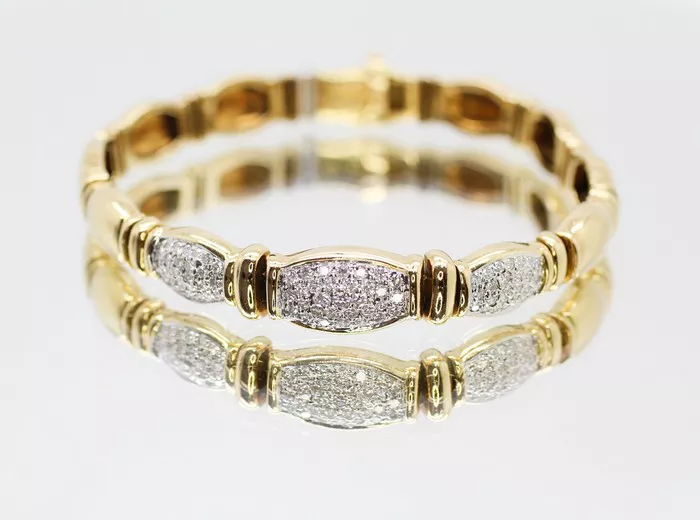Bracelets are versatile accessories that can add a touch of elegance, personality, or symbolism to any outfit. Whether adorned with gemstones, crafted from precious metals, or designed with intricate beads, bracelets come in various styles and sizes to suit different preferences and occasions. One of the most critical factors in selecting and wearing a bracelet is ensuring if a bracelet fits comfortably on your wrist. This article explores the intricacies of bracelet sizing, offering insights into how to determine the right fit, considerations for different bracelet types, and expert tips for achieving optimal comfort and style.
Understanding Bracelet Sizing
Standard Bracelet Sizing: Bracelets typically come in standard sizes that correspond to wrist measurements. Common sizes range from small (typically 6 to 6.5 inches) to large (7.5 to 8 inches), with variations available to accommodate different wrist circumferences. Understanding these sizes can help in selecting a bracelet that fits snugly but comfortably.
Adjustable and Custom Sizing: Some bracelets feature adjustable elements such as extenders, sliding knots, or stretch designs, allowing for flexibility in sizing. Custom sizing options are also available, where bracelets can be tailored to fit specific wrist measurements for a personalized fit.
Determining Your Wrist Size
Measuring Your Wrist: To determine your wrist size accurately, use a flexible measuring tape or a piece of string to wrap around the wrist at its widest point. Note the measurement in inches or centimeters, ensuring the tape or string is snug but not tight. This measurement serves as a baseline for selecting the appropriate bracelet size.
Considering Comfort and Movement: While measuring your wrist size is essential, consider factors such as comfort and movement when choosing a bracelet. A bracelet should fit comfortably without constricting blood flow or causing discomfort during everyday activities.
Types of Bracelet Fits
Snug Fit: A snug fit ensures that the bracelet sits securely on the wrist without sliding around excessively. It allows for natural movement while preventing the bracelet from slipping off unintentionally. This fit is ideal for bracelets with clasps or closures that need to be fastened securely.
Loose Fit: A loose fit provides more freedom of movement and may slide slightly up and down the wrist. It is suitable for stretch bracelets or bangles that do not require a secure closure but should still fit comfortably without feeling too tight or too loose.
Adjustable Fit: Adjustable bracelets, such as those with extender chains, sliding knots, or stretch designs, offer versatility in sizing. They can be customized to achieve a comfortable fit and are often preferred for their ease of wear and ability to accommodate varying wrist sizes.
See Also: How Much Does It Cost to Repair a Tiffany Bracelet?
Expert Tips for Ensuring a Proper Fit
Try Before You Buy: Whenever possible, try on the bracelet before making a purchase to assess its fit and comfort. This allows you to gauge how the bracelet feels on your wrist and make adjustments if necessary.
Consider Bracelet Type and Design: Different bracelet types may fit differently based on their construction and materials. For example, a cuff bracelet should fit snugly around the wrist without being too tight, while a beaded bracelet may have a slightly looser fit to accommodate the beads.
Account for Clasps and Closures: Pay attention to the type of clasp or closure used on the bracelet. Ensure that it is secure when fastened and does not pinch or irritate the skin. Clasps should be easy to operate while providing a secure hold.
Consult with a Jeweler: For bracelets with custom sizing options or specific design features, consult with a jeweler or retailer specializing in fine jewelry. They can provide guidance on sizing, adjustments, and maintenance to ensure the bracelet fits comfortably and securely.
Common Misconceptions and Challenges
Assuming One Size Fits All: Not all bracelets are designed to fit universally. Different styles and materials may require different sizing considerations to achieve the desired fit and comfort level.
Overlooking Adjustability: Adjustable bracelets offer flexibility in sizing but require proper adjustment to ensure a secure fit. Be mindful of sliding knots, clasps, or extender chains that may need periodic adjustments to maintain comfort and security.
Maintenance and Care Tips
Cleaning Regularly: Keep your bracelet clean and free from dirt or debris that can affect its appearance and durability. Follow manufacturer’s guidelines for cleaning specific materials such as gemstones, metals, or beads.
Storing Properly: Store bracelets in a jewelry box or pouch to prevent tangling, scratches, or damage from exposure to sunlight and humidity. Consider separating bracelets with delicate gemstones or metals to avoid potential abrasion.
Conclusion
In conclusion, the right fit is essential when selecting and wearing a bracelet, ensuring both comfort and style. By understanding bracelet sizing, considering different fit types, and following expert tips for achieving optimal fit, individuals can confidently choose bracelets that enhance their personal style and complement their lifestyle.
Whether selecting a bracelet for everyday wear, professional settings, or special occasions, the perfect fit enhances the bracelet’s appeal and allows wearers to enjoy its beauty and significance with ease. Embrace the versatility of bracelets as accessories that not only adorn the wrist but also reflect individuality and personal taste through thoughtful selection and proper sizing.

